
 Podcasts
PodcastsCatch the latest PR news & updates with PRovoke Media's PR Podcasts. Lifting the lid on key industry stories & trends, join our listeners of PR podcasts today.
 Videos
VideosLatest video interviews and campaigns from PRovoke Media, previously known as the Holmes Report.
Long-form journalism that analyzes the issues, challenges and opportunities facing the business and practice of PR.
 Profiles & Interviews
Profiles & InterviewsExplore PR profiles and interviews with leaders from the marketing and PR worlds.
 Crisis Review
Crisis ReviewPR Crisis & Business Crisis review. PRovoke Media's annual analysis of the top reputation crises to rock the corporate sector. Read on here.
 Coronavirus
CoronavirusPRovoke Media's coverage of the Covid-19 crisis, focusing on corporate communication, public affairs & PR industry fallout.
 Trend Forecasts
Trend ForecastsPRovoke Media's PR Trends round up. PRovoke Media's annual forecast of PR trends and news that will impact the PR world in the year ahead...
 Social & Digital
Social & DigitalDedicated to exploring the new frontiers of PR as it dives deeper into social media, content and analytics.
 Technology
TechnologyOur coverage of key technology PR trends and challenges from around the world of digital communications.
 Consumer
ConsumerFrom brand marketing to conscious consumerism, coverage of key marketing and PR trends worldwide.
 Employee Engagement
Employee EngagementPRovoke Media's coverage, analysis and news around the rapidly-shifting area of employee engagement and internal communications.
 Sports Marketing
Sports Marketing Sports PR news, diversity & inclusion trends, views and analysis from PRovoke Media. Subscribe today for the very latest in the world of sports communications.
 Global PR Agency Rankings
Global PR Agency RankingsPRovoke Media's definitive global benchmark of global PR agency size and growth.
Enter PRovoke Media's 2024 Global 250 Agency Ranking and/or our Agencies of the Year competitions now.
 Agencies of the Year
Agencies of the YearPRovoke Media's annual selections for PR Agencies of the Year, across all of the world's major markets.
 Innovator 25
Innovator 25PRovoke Media profiles marcomms innovators from across North America, EMEA and Asia-Pac.
 Creativity in PR
Creativity in PRIn-depth annual research into the PR industry's efforts to raise creative standards.
 Asia-Pacific Communication Index
Asia-Pacific Communication IndexAPACD/Ruder Finn annual study of Asia-Pacific in-house communications professionals.
 SABRE Awards
SABRE AwardsThe world's biggest PR awards programme, dedicated to benchmarking the best PR work from across the globe.
 PRovokeSummit Global
PRovokeSummit GlobalThe biggest PR conference of the year, a high-level forum designed to address the critical issues that matter most.
 PRovoke Media Regional Series
PRovoke Media Regional SeriesA global network of conferences that explore the innovation and disruption that is redefining public relations.
 Agencies of the Year
Agencies of the YearUnrivalled insight into the world's best PR agencies, across specialist and geographic categories.
 Roundtables
RoundtablesOur Roundtables bring together in-house comms leaders with PR firms to examine the future of communications.
 Agency Playbook
Agency PlaybookThe PR industry’s most comprehensive listing of firms from every region and specialty
.jpg) All Jobs
All JobsFind the latest global PR and communications jobs from PRovoke Media. From internships to account executives or directors. See all our PR jobs here.
PRovoke Media's editorial series published in collaboration with partners.
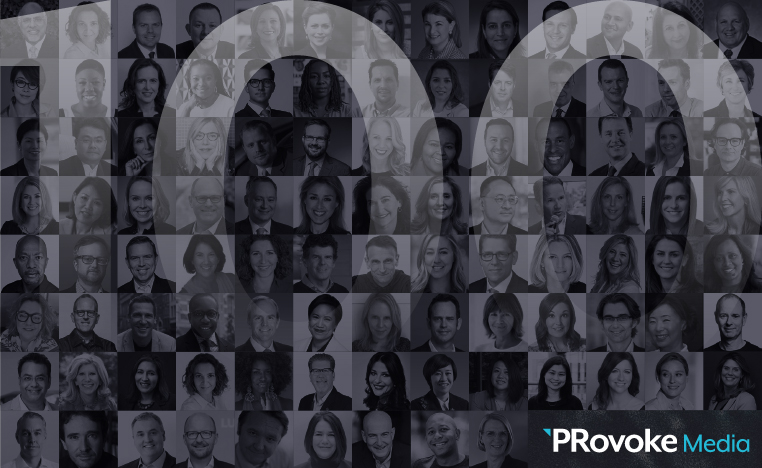
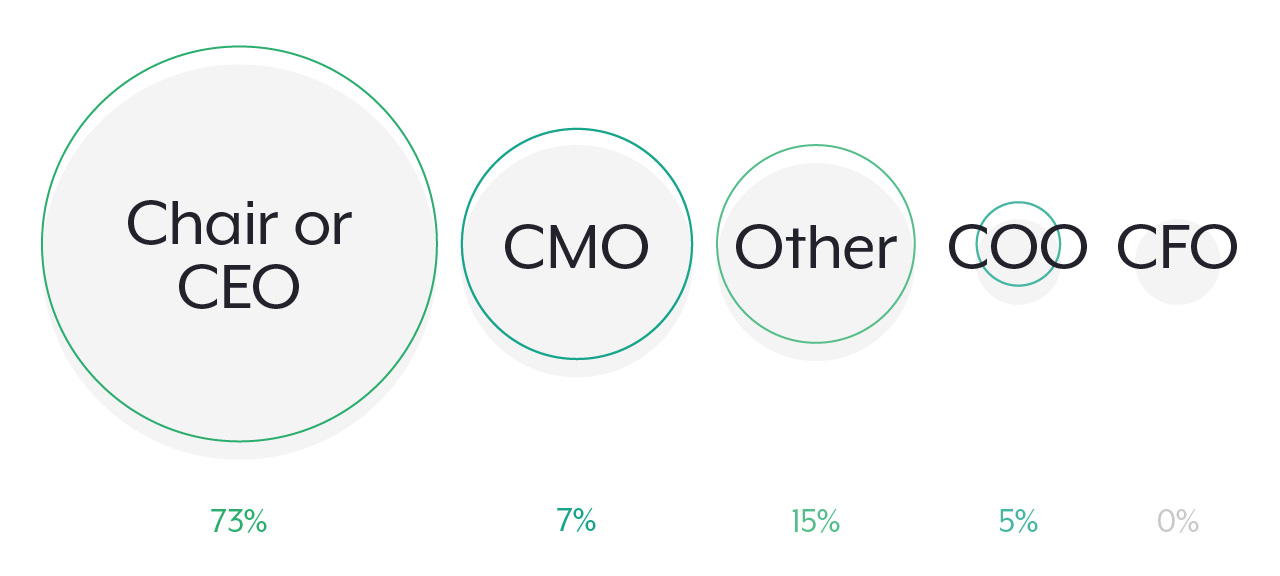 The number of CMOs and CCOs reporting into the chief executive or chair of their organisation is high and stable this year: 73%, compared to 74% last year, which was a big leap up from 64% in 2018. Oversight of CCOs by the chief marketing officer dipped again, from 14% in 2018, to 8% in 2019, to just under 7% this year. A similar number to 2019 report into the chief operations officer: 4%, compared to 5% in 2019, while many more of our cohort report into varied functions than last year (15% vs 8%), including titles such as heads of corporate or public affairs, chiefs of staff, deputy CEOs and chief transformation officers. None of our influencers this year report into the chief finance officer, compared to 5% in 2019.
The number of CMOs and CCOs reporting into the chief executive or chair of their organisation is high and stable this year: 73%, compared to 74% last year, which was a big leap up from 64% in 2018. Oversight of CCOs by the chief marketing officer dipped again, from 14% in 2018, to 8% in 2019, to just under 7% this year. A similar number to 2019 report into the chief operations officer: 4%, compared to 5% in 2019, while many more of our cohort report into varied functions than last year (15% vs 8%), including titles such as heads of corporate or public affairs, chiefs of staff, deputy CEOs and chief transformation officers. None of our influencers this year report into the chief finance officer, compared to 5% in 2019.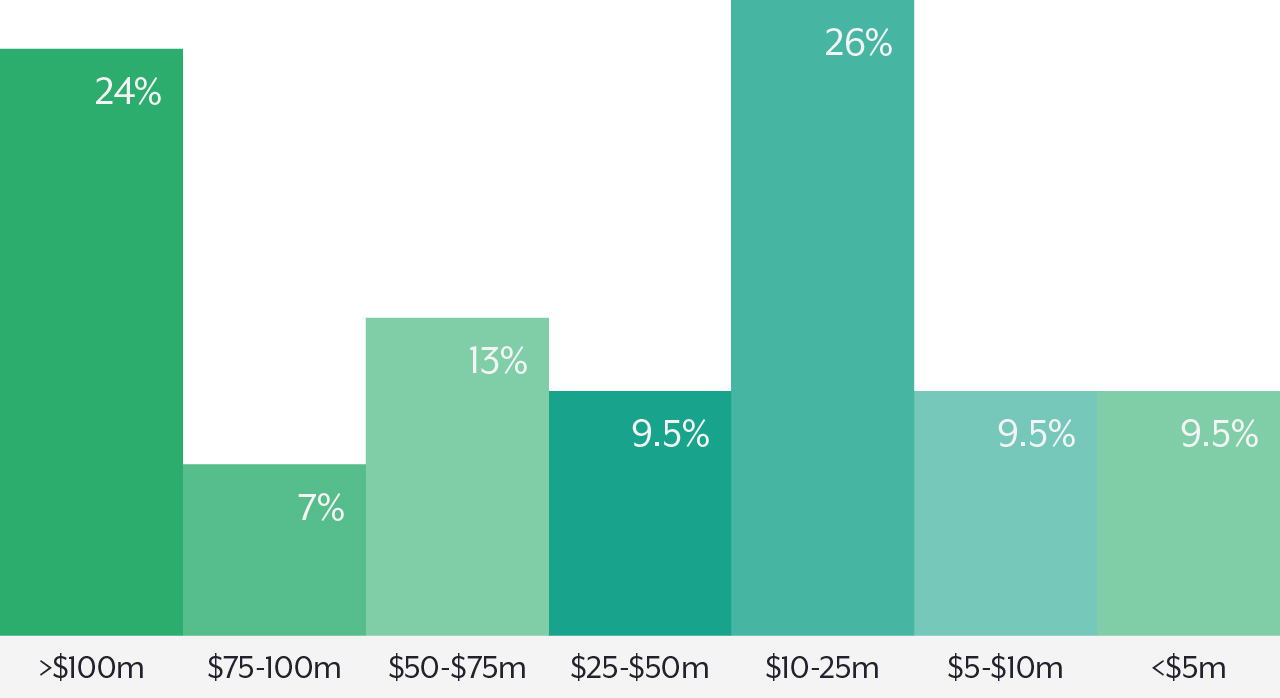 Our Influence 100 now control PR spend of more than $4.2bn – down a not-surprising but significant amount from last year’s total of $4.8bn. This is still up on 2018’s $3.3bn, although much less than the $6.5bn recorded when this survey launched in 2012.
Our Influence 100 now control PR spend of more than $4.2bn – down a not-surprising but significant amount from last year’s total of $4.8bn. This is still up on 2018’s $3.3bn, although much less than the $6.5bn recorded when this survey launched in 2012.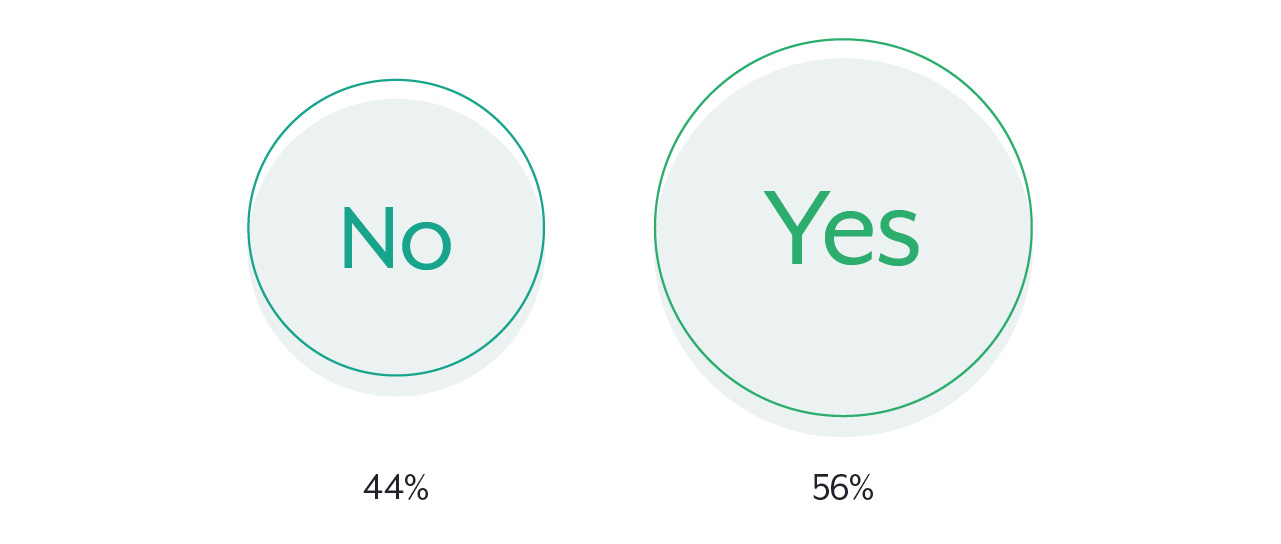 We also asked an open-ended question about how much budgets had increased or reduced by for 2020. The majority said budgets had been flat, and a healthy number said budgets had increased by between 5% and 50% for the year, but a large proportion said 2020 budgets have been lower on 2019, from 5% cuts to a halving of the previous year, with a notable number saying 2020 was around 20% down on 2019.
We also asked an open-ended question about how much budgets had increased or reduced by for 2020. The majority said budgets had been flat, and a healthy number said budgets had increased by between 5% and 50% for the year, but a large proportion said 2020 budgets have been lower on 2019, from 5% cuts to a halving of the previous year, with a notable number saying 2020 was around 20% down on 2019. PR budgets include a wider range of activities than ever. The areas that have swallowed up most spend this year and are anticipated to be major areas of spend next year include corporate reputation (75%, compared to 79% last year) and traditional public relations (66%, down from 71% last year. In terms of social media, 36% said they expected paid social to be a significant area of spend, up from 29% last year and 19% in 2018, while the number who said they would be spending a serious slice of their budget on organic social leapt from 29% to 55%, the biggest increase this year.
PR budgets include a wider range of activities than ever. The areas that have swallowed up most spend this year and are anticipated to be major areas of spend next year include corporate reputation (75%, compared to 79% last year) and traditional public relations (66%, down from 71% last year. In terms of social media, 36% said they expected paid social to be a significant area of spend, up from 29% last year and 19% in 2018, while the number who said they would be spending a serious slice of their budget on organic social leapt from 29% to 55%, the biggest increase this year.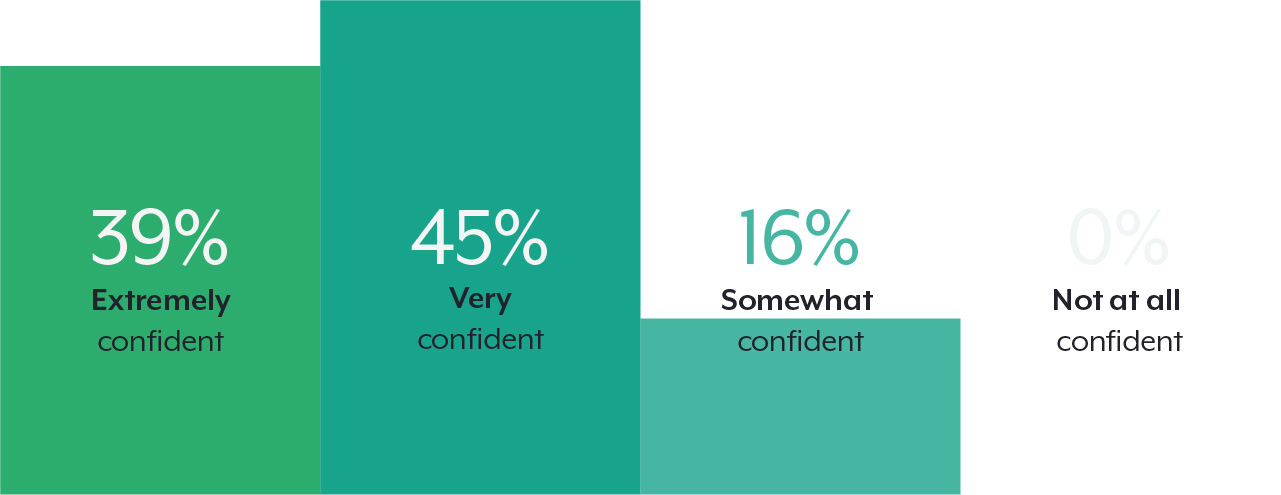 Despite something of a wobbly picture on the budget front, confidence among our CMOs and CCOs was perhaps higher than expected: 39% said they were extremely confident about the resilience of the sector they operate in and another 45% said they were very confident. Only 16% sounded a note of caution by saying they were somewhat confident, and none of our respondents said they lacked all confidence in the future of their sector.
Despite something of a wobbly picture on the budget front, confidence among our CMOs and CCOs was perhaps higher than expected: 39% said they were extremely confident about the resilience of the sector they operate in and another 45% said they were very confident. Only 16% sounded a note of caution by saying they were somewhat confident, and none of our respondents said they lacked all confidence in the future of their sector. 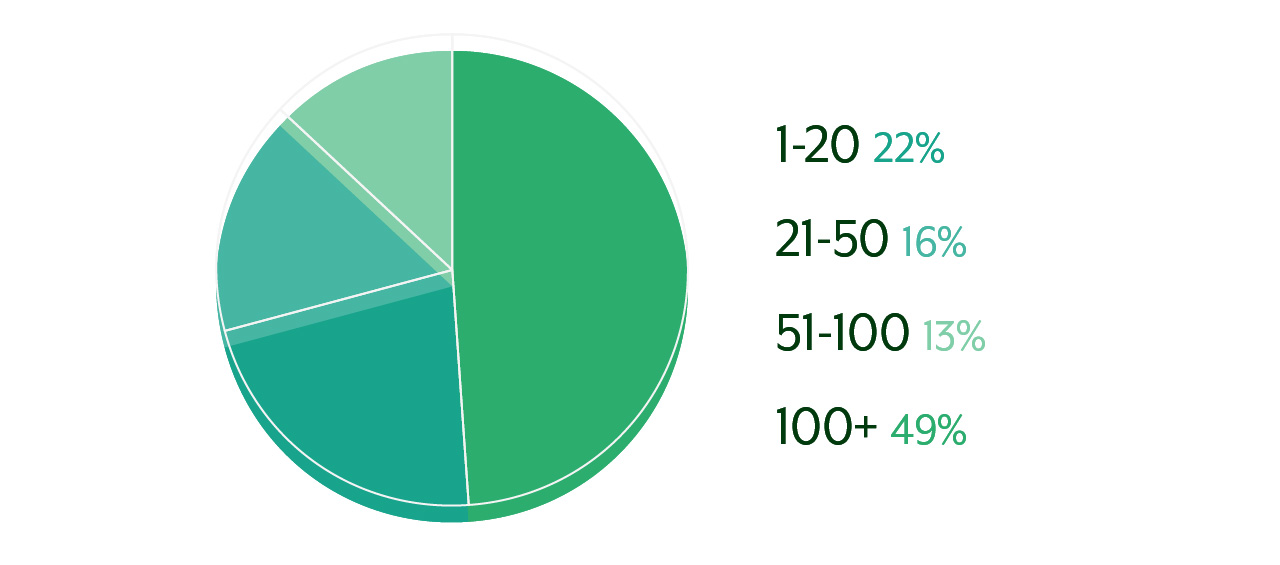 The number who manage teams of more than 100 people rose again this year, from 38% in 2018 and 41% in 2019 to 49% this year. The number managing teams of 50-100 was down from 19% to 13%, while 16% manage a team of 21-50, compared to 14% last year, and 22% have a small in-house team of 20 or less, compared to 27% last year.
The number who manage teams of more than 100 people rose again this year, from 38% in 2018 and 41% in 2019 to 49% this year. The number managing teams of 50-100 was down from 19% to 13%, while 16% manage a team of 21-50, compared to 14% last year, and 22% have a small in-house team of 20 or less, compared to 27% last year.
 The Influence of our 100 this year again ranges much further than public relations, in terms of being primary decision makers beyond PR agencies, where 98% are responsible for hiring (up from 92% last year). This year, 64% of respondents were the primary decision-maker for digital/social agencies (up from 53% last year) and 32% said the same of advertising agencies, down slightly from 36% last year. Other specialist agencies managed by our cohort included brand and design, transformation and sustainability, public affairs, financial, content, media buying, measurement, research and events.
The Influence of our 100 this year again ranges much further than public relations, in terms of being primary decision makers beyond PR agencies, where 98% are responsible for hiring (up from 92% last year). This year, 64% of respondents were the primary decision-maker for digital/social agencies (up from 53% last year) and 32% said the same of advertising agencies, down slightly from 36% last year. Other specialist agencies managed by our cohort included brand and design, transformation and sustainability, public affairs, financial, content, media buying, measurement, research and events.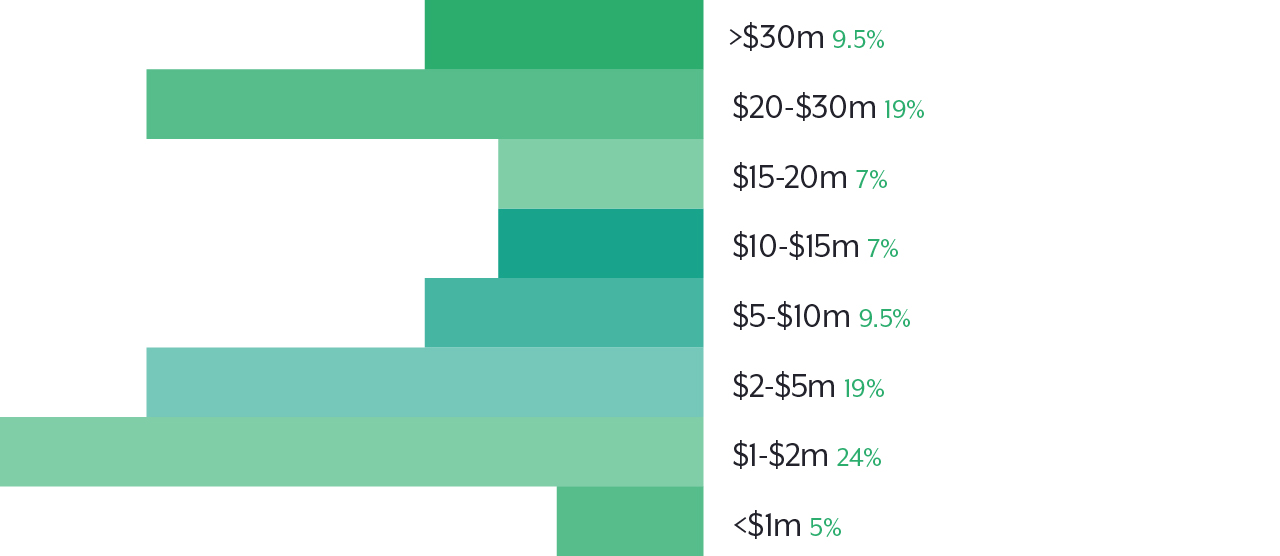 Agency spend appears to be up, with 28.5% spending more than $20m on their PR agency partners, compared to 17% last year. The same proportion spent between $2m and $10m, while 14% had a PR budget of $10m-$20m. At the lower end, the number of respondents spending less than $1m was way down on the previous two years: 5% compared to 17% in 2019 and 20% in 2018.
Agency spend appears to be up, with 28.5% spending more than $20m on their PR agency partners, compared to 17% last year. The same proportion spent between $2m and $10m, while 14% had a PR budget of $10m-$20m. At the lower end, the number of respondents spending less than $1m was way down on the previous two years: 5% compared to 17% in 2019 and 20% in 2018.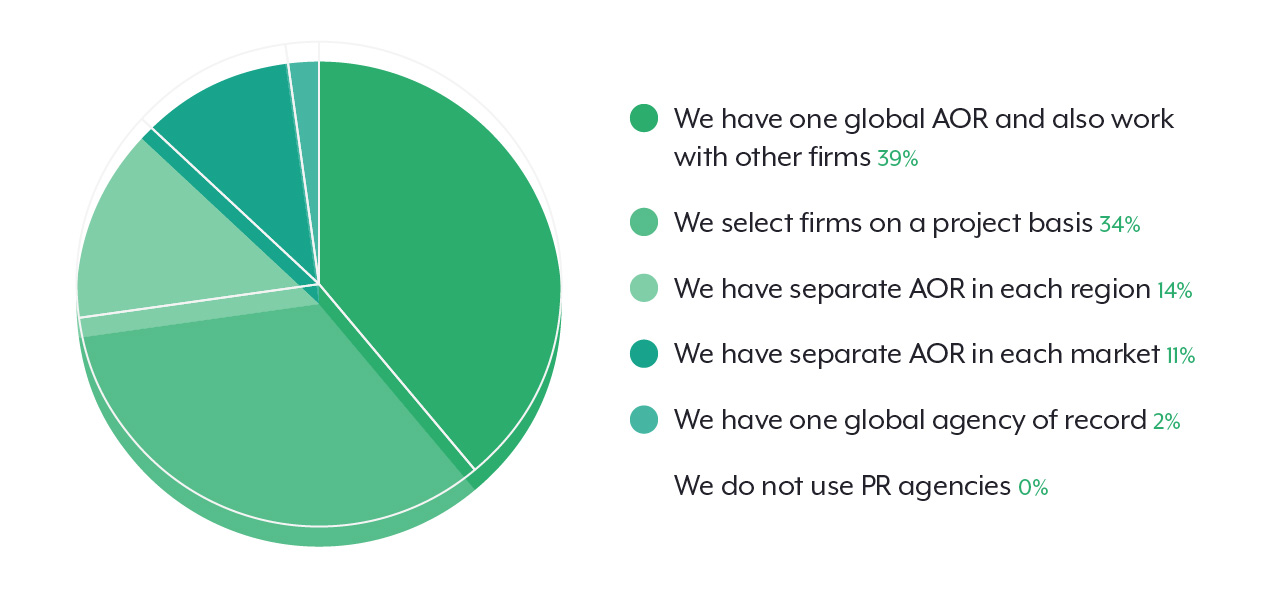 Only 2% of our CMOs and CCOs say they have one global PR agency of record, down from 6% last year. The number who said they have a global AOR, but also work with other firms was 39%, around the same as last year. There was a rise in the proportion of respondents who use regional agencies of record, from 9% to 14%, and a fall in those who have separate agencies in each market, from 17% to 11%. The trend for selecting firms on a project basis is rising again, with 34% saying this was their preferred way of working with agencies, compared to 23% last year. And compared to last year, when 6% of our influencers said they did not use PR agencies, this year every single respondent said they used at least one PR agency.
Only 2% of our CMOs and CCOs say they have one global PR agency of record, down from 6% last year. The number who said they have a global AOR, but also work with other firms was 39%, around the same as last year. There was a rise in the proportion of respondents who use regional agencies of record, from 9% to 14%, and a fall in those who have separate agencies in each market, from 17% to 11%. The trend for selecting firms on a project basis is rising again, with 34% saying this was their preferred way of working with agencies, compared to 23% last year. And compared to last year, when 6% of our influencers said they did not use PR agencies, this year every single respondent said they used at least one PR agency.
Not surprisingly, there has been a shift in the perceived value that agencies bring to their clients this year, with a leap in the number of CCOs and CMOs who said they most valued agencies’ strategic counsel, from 13% last year to 26% this year. There was an even bigger corresponding drop – from 36% to 19% – in the number of those saying creative thinking and new ideas had been the greatest benefit of working with an agency in the year of the pandemic. And there’s even more of a focus on tactical and execution support, up from 43% to 49%.
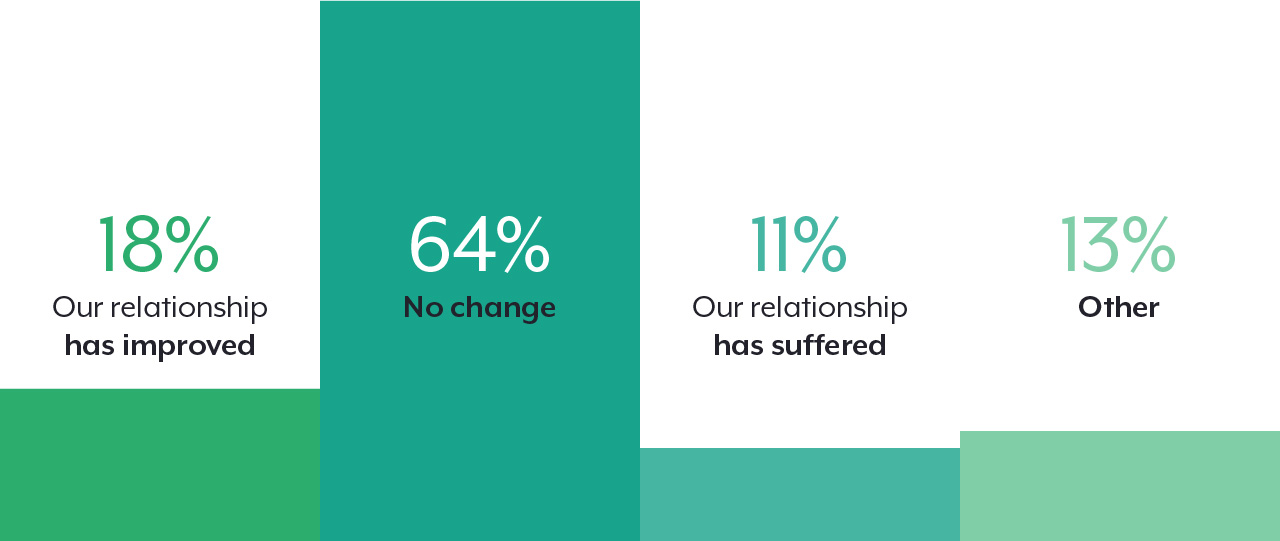
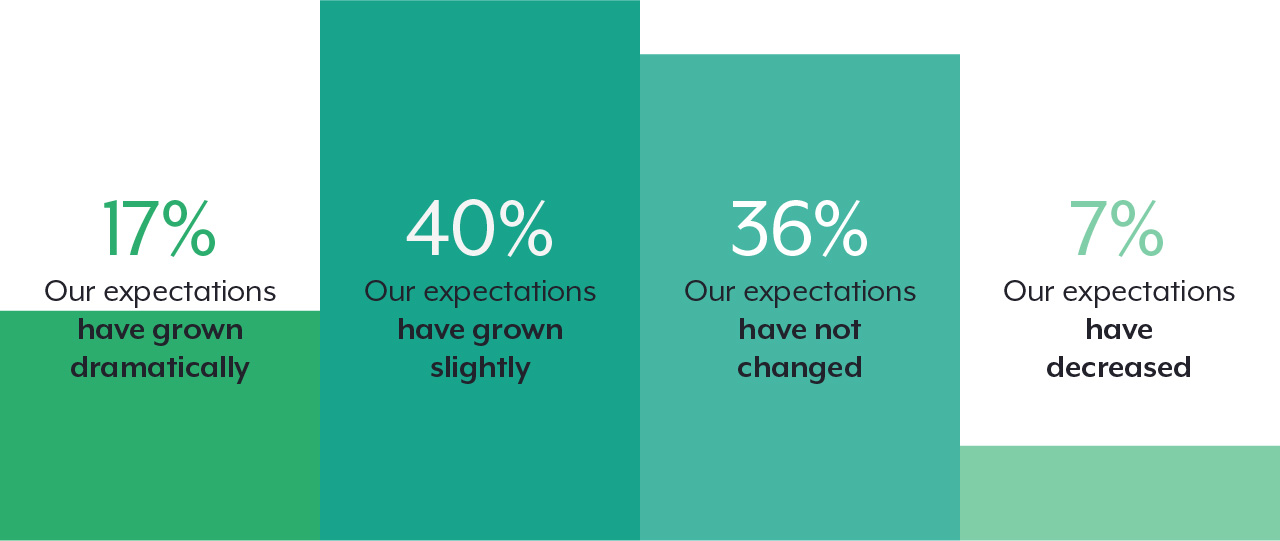 We added two new lockdown questions this year to gauge how relationships and expectations have shifted during the pandemic. Showing how quickly the industry has adapted to the new remote working environment globally, 64% of our influencers said there had been no change to their relationships with their PR agencies, and a notable 18% actually said it had improved. However, a not-insignificant 11% said their relationships with their PR agencies had suffered because of home working. Other comments were largely positive, including: “Operations are different, but relationships remain intact”; “Tighter collaboration”; “The work that can be done has changed but the relationships are unchanged.” There were a couple of less positive points made, however, such as: “Think agencies got scared, justifiably, and have been less proactive”; “It has not suffered but building trust is more challenging through remote working.”
We added two new lockdown questions this year to gauge how relationships and expectations have shifted during the pandemic. Showing how quickly the industry has adapted to the new remote working environment globally, 64% of our influencers said there had been no change to their relationships with their PR agencies, and a notable 18% actually said it had improved. However, a not-insignificant 11% said their relationships with their PR agencies had suffered because of home working. Other comments were largely positive, including: “Operations are different, but relationships remain intact”; “Tighter collaboration”; “The work that can be done has changed but the relationships are unchanged.” There were a couple of less positive points made, however, such as: “Think agencies got scared, justifiably, and have been less proactive”; “It has not suffered but building trust is more challenging through remote working.”
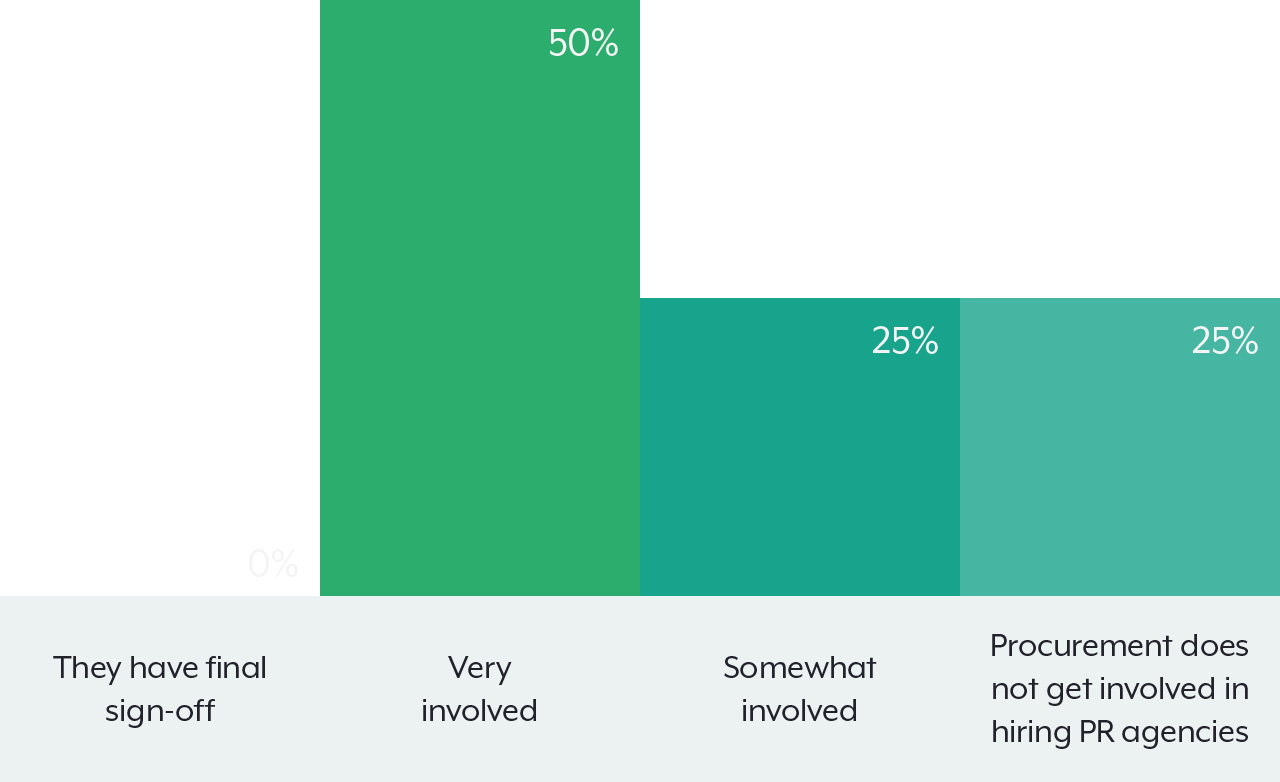 The number of CCOs and CMOs preferring to hire agencies via a traditional RFP pitch process was slightly down this year, from 37.5% to 32%, while the number preferring to run an invitation-only process was up slightly from 50% to 52%. The number of respondents who prefer to hire an agency they have previously worked with was up from 3% to 9%, and those using referral networks was down slightly from 9% to 7%.
The number of CCOs and CMOs preferring to hire agencies via a traditional RFP pitch process was slightly down this year, from 37.5% to 32%, while the number preferring to run an invitation-only process was up slightly from 50% to 52%. The number of respondents who prefer to hire an agency they have previously worked with was up from 3% to 9%, and those using referral networks was down slightly from 9% to 7%. 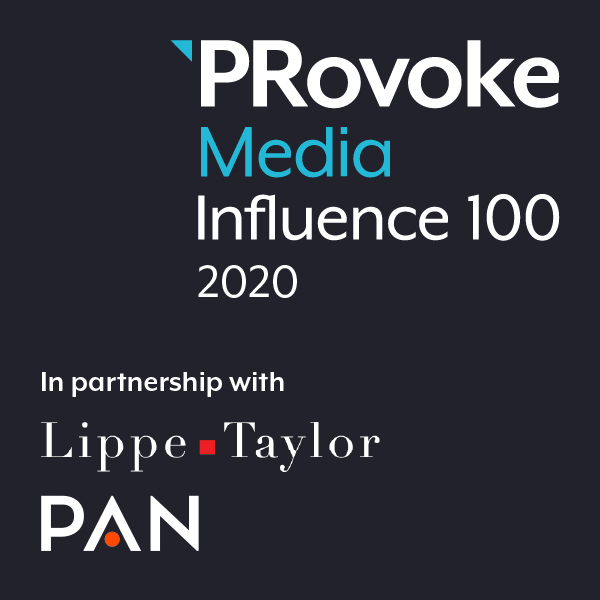




Intelligence and insight from across the PR world.
About PRovoke Media Contact Us Privacy & Cookie PolicyWe feel that the views of the reader are as important as the views of the writer. Please contact us at [email protected]
Signup For Our Newsletter Media Kits/Editorial Calendar Jobs Postings A-Z News Sitemap© Holmes Report LLC 2024